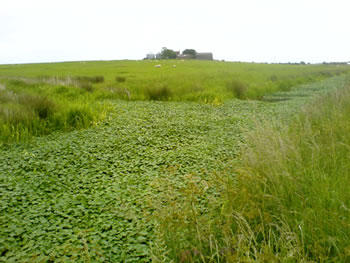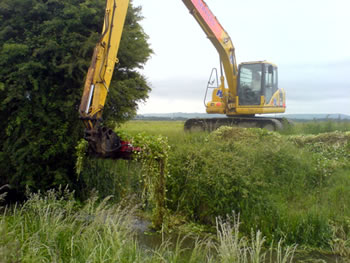
Expert Working group on PRA for Hydrocotyle ranunculoides
Paris, 2009-03-23/25
Hydrocotyle ranunculoides originates from the Americas and was introduced into the EPPO region as an ornamental plant for tropical aquaria and garden ponds. It is still sold in the region. The plant was first recorded as naturalised in the south-east of the UK in the 1980s. Naturalisation in the Netherlands and in Belgium was recorded in the 1990s. Deleterious impacts have been reported in these three countries. The species is also recorded in France, Ireland, Italy, Germany but several EPPO countries are still free from H. ranunculoides and there are concerns that it may be able to enter and establish in further countries.


Invasion of a stream by H. ranunculoides in the UK. Mechanical removal of H. ranunculoides in the UK.
Pictures: J. Newman
An initial EPPO PRA was performed and approved in 2005 by the EPPO Council. After the proposal for listing this species in the Directive 2000/29/EC, the European Food Safety Authority (EFSA) reviewed the initial PRA. The initial PRA has therefore been revised to take into account the EFSA comments and new information that is available.
The plant has already entered the EPPO region. It is no longer imported, but is produced and traded even if in low quantities. The species has already established in at least 7 countries of the EPPO region, and according to the climatic prediction, additional countries are at risk (e.g.: Mediterranean countries, Black Sea area). Moreover, spread by human activities is very effective.
Economic impacts include management costs of the species and flooding of areas. The species also has environmental impacts as it can invade slow flowing waters, degrade aquatic ecosystem and lead to a loss of biodiversity. Additionally, H. ranunculoides has an impact on navigation, recreational activities and fishing.
As an overall conclusion, the risk of establishment of H. ranunculoides in waterways, and negative impacts on their vegetation and use, justifies measures to prevent its further spread in the EPPO region.
The conclusions of the EWG have been reviewed by different bodies in the EPPO system in 2009 and were presented to the EPPO Council.
The Expert Working Group was composed of:
Mr Guillaume Fried (LNPV Station de Montpellier, SupAgro, FR)
Mr Andreas Hussner (Institut für Botanik, Universitaet Duesseldorf, DE)
Mr Jonathan Newman (CEH Wallingford, UK)
Ms Gritta Schrader (Julius Kühn Institut (JKI) DE),
Mr Ludwig Triest (Algemene Plantkunde en Natuurbeheer (APNA), BE)
Mr Johan van Valkenburg (Plant Protection Service, NL)
Ms Sarah Brunel (EPPO Secretariat)
